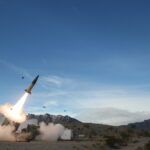Iran’s missile tests: What exactly did they use, and what does it mean?
By Dina Esfandiary, Michael Elleman | February 16, 2017
On January 29, Iran tested a new ballistic missile that reportedly reached a distance of about 1,000 kilometers. Little is known about the missile named “Khorramshahr,” including where its technology comes from and what it targets. The test caused an uproar because many observers claimed that it was a violation of UN Security Council Resolution 2231—though not of the nuclear deal concluded in the summer of 2015. The test reflects Iran’s testing of boundaries after the deal. Can this be managed or will it spiral out of control?
The tested missile traveled far, but its re-entry vehicle reportedly exploded before the flight was complete. It’s unclear whether this was accidental or deliberate. It’s important to determine what Iran launched to provide insight into Tehran’s intentions and whether this was a violation of Resolution 2231 or not.
What types of missiles did the regime use? There are four plausible possibilities:
First, Tehran has a stockpile of Nodong missiles imported from North Korea in the 1990s. The Shahab-3, as it is called, was first tested in 1998 and has a range of about 950 kilometers when carrying a 1,000-kilogram warhead. Iran modified this to create the Ghadr—and more recently the Emad—missiles, both of which can hit a target up to roughly 1,600 km away while carrying a 750-kg payload. If the test involved a modified Ghadr or Emad, then the new Khorramshahr missile would have taken a lofted trajectory—one in which the rocket travels higher, but to a shorter distance. Enhancement of the Ghadr or Emad is consistent with Iran’s missile development priorities. Tehran sought to advance the military usefulness of its missile forces by improving their accuracy and using warheads filled with bomblets that can be dispersed over a larger area near the target. This has taken precedence over the development of missiles with ranges above 2,000 km.
Two, Iran could have modified its Shahab-1 and -2 (Scud-B and –C) missiles, which were imported from North Korea roughly two dozen years ago. In 2010, Iran reconfigured the 500-km range Shahab-2 to a 700-km Qiam missile, whose limited range would seemingly eliminate it as the possible subject of the recent test flight. In July 2016, North Korea introduced a missile powered by a Scud engine with a maximum range of about 1,000 km. It’s reasonable to assume that Pyongyang may have included a handful of them to Iran when it shipped the 200 to 300 Scud-B and -C missiles during the late-1980s and early-1990s. To achieve its maximum range of roughly 1,000 km, the one-meter diameter Scud would fly on a minimum-energy trajectory, which would clearly distinguish it from the more lofted path used by a Ghadr or Emad.
Three, Iran has been developing a two-stage, solid-fueled missile known as the Sajjil, though it has not been tested since 2011. A missile based on Sajjil’s first stage has an approximate reach of 1,000 km, making it well suited for use against targets throughout the Gulf, while being launched from deep inside Iranian territory
Finally, Iran could have tested a BM-25 missile, but this is unlikely. If the BM-25 mirrors North Korea’s Musudan missile, it would have a range of roughly 3,000 km. But US national-security officials are on record as saying that the missile tested by Iran in January was a medium-range missile, while the BM-25 or Musudan is classified as an intermediate-range system (which has a greater range, of about 3,000 to 5,500 km). Further, it is unclear why Iran would test a BM-25 to a distance of only 1,000 km, using a highly-lofted trajectory, when it has access to a flight corridor to accommodate a full-range flight. The highly-lofted trajectory would have been detected and tracked by US radars and sensors in the region, and its flight path would be easy to distinguish from those taken by other missiles.
The type of engine the Khorramshahr missile relies on is an also important indicator of Iranian intentions and future capabilities. The Ghadr/Emad missiles rely on the Nodong engine, while the ubiquitous Isayev 9D21 engine powers the Scud. Both the Nodong and Scud engines employ low-performing propellants (kerosene and nitric acid), which make it difficult to fashion viable, road-mobile, intercontinental-range ballistic missiles (ICBMs). Sajjil’s solid-propellant technology could provide the foundation for an operational ICBM, but it would likely require seven years to develop—and that’s an optimistic timeframe. Finally, if the Khorramshahr is based on the high-performance, R-27 engine (Isayev 4D10), Iran would have the building blocks needed to develop a viable, two-stage ICBM within four or five years. But that would require Tehran to procure dozens of additional 4D10 engines.
So what does this mean for policy-making on Iran? After the 2015 nuclear deal with Iran, known as the Joint Comprehensive Plan of Action (JCPOA), Tehran quickly adhered to its obligations. But the deal—much like the negotiations that preceded it—became a means for internal politicking: Different factions in Tehran used it to discredit their opponents and President Rouhani’s administration. Many in Tehran did not support the nuclear deal because it constrained Iran. It took deft maneuvering on the part of President Rouhani and Supreme Leader Khamenei to get Iran’s Revolutionary Guards to reluctantly agree to it, for example.
But that meant that challenges to it were likely to continue and even worsen in the run-up to the Iranian elections in May.
Can this be managed? In November 2016, Iran accumulated a stockpile of heavy water beyond the 130 tons allowed by the JCPOA. This was the second time this happened, making it look deliberate. But the issue was quickly managed through dialogue. Once Iran saw that a unified international community acted swiftly and effectively to address the issue, it backed down. Within days, the excess heavy water was shipped out to Oman, and Iran was found to be in compliance again.
Missile tests have always been more complicated.
The JCPOA doesn’t address Iran’s missile program. This was deliberate: Iran steadfastly rejected including the missile effort in the negotiations because Tehran deemed it to be a legitimate defense program. But Resolution 2231, which endorsed the deal, “calls upon” Iran to cease testing of missiles that are designed to be capable of delivering nuclear weapons.The resolution deliberately uses “calls upon” to make the measure binding. But all Iran has to do to claim that it is respecting the resolution is state that the tested missile is not designed to carry a nuclear warhead—which it did. As a result, unless it can be proven that the tested missile was designed to carry a warhead, the test was not a violation of the letter of the resolution per se. But it is inconsistent with the spirit of 2231.
What’s more, the missile program is under control of the Revolutionary Guards. It’s no surprise that they boldly continue to conduct missile testing even after multiple calls for them to stop. The timing of this test is also no surprise: The Revolutionary Guards want to test the new US administration and explore the direction that the tone of US-Iran interactions will take under President Trump.
As a result, managing challenges to the JCPOA is essential. After all, the international community is better off with the nuclear deal than without it: Iran’s nuclear program is severely curtailed for the foreseeable future, with the IAEA’s eyes on all aspects of it. Even those who opposed the deal, including the Gulf Arab governments, called for President Trump to maintain it. The deal must be implemented robustly and not be affected by this missile-testing spoiler.
The only way to do this is through dialogue. The United States will not be able to ban Iranian missile development or testing. But it could make clear that what really matters is not testing missiles using R-27 technology, or missiles capable of flying beyond 2,000 km—in other words, missiles that come dangerously close to being potentially used as relatively long-range platforms for carrying nuclear weapons.
Iran has said publicly it doesn’t need such missiles. While under the previous administration such a negotiation could have been conceivable through a “more-for-more” framework—where Iran would get more in return for giving up more—the Trump administration has now made this impossible through its rhetoric. What’s more, the Revolutionary Guards aren’t fond of dialogue with the West. But like with negotiations on the nuclear deal, the Guards could be put under pressure by Iran’s Supreme Leader Ayatollah Khamenei and President Rouhani to scale back their activities, should they be given reason to do so. If that fails, then these challenges to the JCPOA could be de-escalated through dialogue; aggressive rhetoric is not the way forward.
Interestingly, while the rhetoric against Iran was aggressive, the Trump administration did not follow it with aggressive action. While additional sanctions were imposed a week after the recent missile test, the designations were no different from the Obama administration’s sanctions. The fear is that actions will eventually escalate, or that the aggressive rhetoric on its own may be enough to scuttle the deal and put the United States on the path to war with Iran.
Together, we make the world safer.
The Bulletin elevates expert voices above the noise. But as an independent nonprofit organization, our operations depend on the support of readers like you. Help us continue to deliver quality journalism that holds leaders accountable. Your support of our work at any level is important. In return, we promise our coverage will be understandable, influential, vigilant, solution-oriented, and fair-minded. Together we can make a difference.
Topics: Analysis, Nuclear Weapons, Technology and Security
















